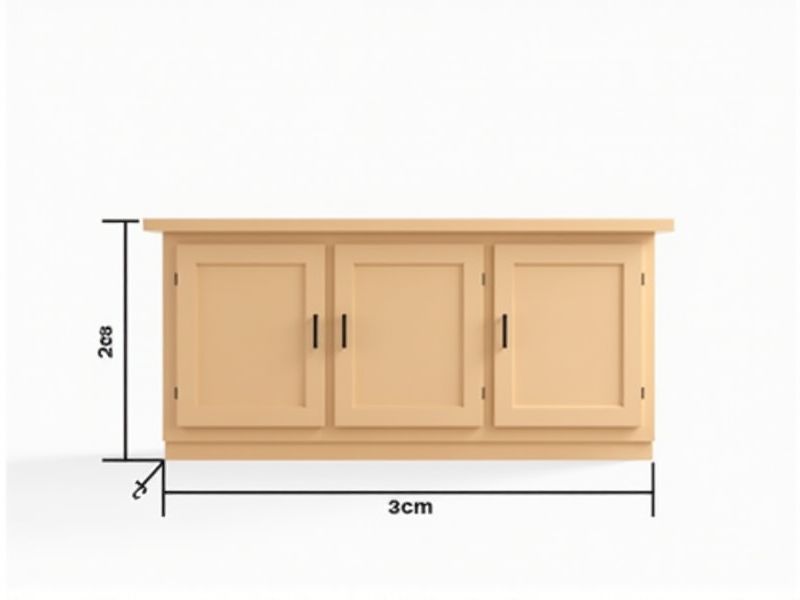
When planning for an island cabinet, standard dimensions play a crucial role in ensuring both functionality and comfort. Typically, the standard width of an island cabinet ranges from 24 to 48 inches, with a depth of about 24 to 36 inches. The standard height is generally the same as your kitchen counters, usually around 36 inches, but it can be raised to 42 inches if you want a bar-height seating area. Making sure your island has at least 36 to 42 inches of clearance on all sides will also help maintain good traffic flow and usability in your kitchen.
Width
Island cabinet widths typically range from 36 to 60 inches, catering to various kitchen layouts. A width of 42 inches is often considered ideal for comfortable movement and accessibility. When selecting your island cabinet, consider the overall kitchen space; maintaining at least 42 inches of clearance around the island enhances functionality. This optimal spacing not only improves workflow but also allows for potential seating arrangements, making your kitchen both practical and inviting.
Length
The standard length for island cabinets typically ranges from 48 to 72 inches, accommodating various kitchen layouts and preferences. A 60-inch island cabinet is particularly popular, offering ample workspace and storage without overwhelming the room. When designing your kitchen, consider additional depth options of 24 to 36 inches to enhance usability. Ensure the island's dimensions complement your overall kitchen flow, allowing for comfortable movement and accessibility.
Height
The standard height for an island cabinet typically ranges between 36 to 42 inches, allowing for comfortable usage whether you're preparing meals or enjoying casual dining. This height is designed to align with the standard countertop height of 36 inches, which ensures ergonomic efficiency while cooking. For bar-height islands, a height of 42 inches accommodates stools that are generally 30 inches tall, creating the perfect setup for social gatherings. You can enhance your kitchen's functionality by considering adjustable legs, which provide flexibility in rise and stability across various floor surfaces.
Depth
The standard depth for an island cabinet typically ranges from 24 to 30 inches, providing ample space for cooking and preparation tasks. This depth not only accommodates standard-sized appliances but also allows for comfortable movement around the island. Depending on your kitchen layout, a deeper island may enhance functionality, especially if you plan to include seating or storage. For optimal workflow, consider the depth in relation to the surrounding countertops, which should generally match at 24 inches.
Overhang
The standard for island cabinets typically emphasizes an overhang of 12 to 15 inches, providing ample space for comfortable seating and a functional workspace. This overhang not only enhances aesthetics but also ensures practical use, allowing for bar stools or casual dining options. When designing your kitchen, consider the cabinet depth, usually around 24 inches, to maintain a harmonious balance between the countertop and the overhang. Proper implementation of overhang standards can significantly improve both the usability and style of your kitchen island.
Clearance
The standard clearance for island cabinets is typically between 36 to 42 inches, allowing for comfortable movement and accessibility in kitchens. When planning your layout, ensure at least 42 inches of space between the island and surrounding cabinets or appliances to facilitate ease of movement. In cramped areas, a minimum clearance of 36 inches may suffice, but this can lead to crowded conditions. Optimal clearance not only enhances functionality but also contributes to a visually appealing and efficient kitchen design.
Walkway Space
The standard design for an island cabinet emphasizes a walkway space of at least 42 to 48 inches to ensure smooth pedestrian traffic. This spacing allows for easy movement around the island while catering to multiple users, providing functionality for cooking and entertaining. When incorporated into a kitchen layout, these dimensions enhance accessibility and prevent congestion, ultimately improving your workflow. A well-planned walkway not only maximizes the efficiency of the kitchen space but also contributes to a visually appealing and organized environment.
Seating Area
The island cabinet designed for the seating area typically measures between 42 to 48 inches in height, offering optimal comfort for diners. Featuring a spacious countertop surface, it provides ample space for food preparation, casual dining, or gatherings. This configuration often includes storage solutions, such as drawers or shelves, maximizing utility without compromising style. Consider adding seating options like barstools, ideally ranging from 30 to 36 inches in height, to enhance the functionality and aesthetic of your space.
Storage Capacity
When selecting an island cabinet, prioritize storage capacity to maximize your kitchen's efficiency. A typical island cabinet can offer anywhere from 15 to 30 cubic feet of storage, depending on its design and configuration. Consider features like pull-out drawers, adjustable shelves, and built-in dividers that enhance organization and accessibility. Optimizing your island cabinet can transform cluttered spaces into efficient, functional areas, catering to your cooking and entertaining needs.
Material Thickness
The standard material thickness for island cabinets typically ranges between 3/4 inch to 1 inch, providing structural integrity and durability. A thickness of 3/4 inch is common for most cabinet materials, while premium options may utilize 1 inch for added strength and a high-end appearance. When selecting your island cabinet, consider factors such as weight distribution and the overall design aesthetic, as thicker materials can enhance visual impact. Properly engineered cabinets at these thicknesses can accommodate heavier countertops and withstand daily usage, ensuring longevity and functionality in your kitchen.
